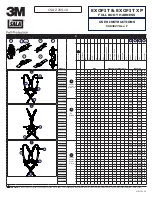
4-28
Maintenance Procedures
Cleaning the sampling cone assembly
You can remove the sampling cone assembly (the sample cone, O-ring, and
cone gas nozzle) for cleaning without venting the instrument.
Removing the sampling cone assembly from the source
Required material
Chemical-resistant, powder-free gloves
To remove the sampling cone assembly from the source
1. Close the source isolation valve (see
Warning:
The source components can be contaminated with
biohazardous and/or toxic materials. Always wear
chemical-resistant, powder-free gloves while performing this
procedure.
Warning:
To avoid electric shock, ensure that the instrument is in
Standby mode before commencing this procedure.
Warning:
To avoid puncture wounds, take great care while working
with the source enclosure open if one or both of these conditions apply:
• An ESI probe is fitted (the probe tip is sharp).
• A corona pin is fitted (the pin tip is sharp).
Warning:
The source can be hot. To avoid burn injuries, take great care
while working with the source enclosure open.
Summary of Contents for Xevo TQD
Page 12: ...xii...
Page 20: ...xx Table of Contents...
Page 23: ...Uses and compatibility 1 3 Xevo TQD TP03406...
Page 24: ...1 4 Specifications and Operating Modes Xevo TQD with visor up TP03407...
Page 42: ...1 22 Specifications and Operating Modes...
Page 52: ...2 10 Preparing for Operation...
Page 76: ...3 24 Changing the Mode of Operation...
Page 194: ...4 118 Maintenance Procedures...
Page 208: ...A 14 Safety Advisories...
Page 234: ...B 26 External Connections...
Page 238: ...C 4 Materials of Construction and Compliant Solvents...
Page 250: ...Index 8...
















































